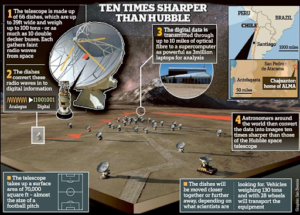In news– The ALMA, a radio telescope comprising 66 antennas located in the Atacama Desert of northern Chile is set to get software and hardware upgrades.
About the ALMA-
- ALMA is a state-of-the-art telescope that studies celestial objects at millimetre and submillimetre wavelengths — they can penetrate through dust clouds and help astronomers examine dim and distant galaxies and stars out there.
- It also has extraordinary sensitivity, which allows it to detect even extremely faint radio signals.
- As mentioned before, the telescope consists of 66 high-precision antennas, spread over a distance of up to 16 km.
- ALMA is operated under a partnership among the United States, 16 countries in Europe, Canada, Japan, South Korea, Taiwan, and Chile.
- Fully functional since 2013, the radio telescope was designed, planned and constructed by the US’s National Radio Astronomy Observatory (NRAO), the National Astronomical Observatory of Japan (NAOJ) and the European Southern Observatory (ESO).
- Over the years, it has helped astronomers make groundbreaking discoveries, including that of starburst galaxies and the dust formation inside supernova 1987A.
- ALMA is situated at an altitude of 16,570 feet (5,050 metres) above sea level on the Chajnantor plateau in Chile’s Atacama Desert as the millimetre and submillimetre waves observed by it are very susceptible to atmospheric water vapour absorption on Earth.
- Moreover, the desert is the driest place in the world, meaning most of the nights here are clear of clouds and free of light-distorting moisture — making it a perfect location for examining the universe.
- The recent upgrades will help it collect much more data and produce sharper images than ever before.
- The most significant modernisation made to ALMA will be the replacement of its correlator, a supercomputer that combines the input from individual antennas and allows astronomers to produce highly detailed images of celestial objects.
- Today, ALMA’s correlators are among the world’s fastest supercomputers. Over the next 10 years, the upgrade will double and eventually quadruple their overall observing speed.

What are some of the notable discoveries made by ALMA?
- With ALMA’s capability of capturing high-resolution images of gas and dust from which stars and planets are formed and materials that could be building blocks of life, scientists are trying to find answers to age-old questions of our cosmic origins.
- One of the earliest findings came in 2013 when it discovered starburst galaxies earlier in the universe’s history than they were previously thought to have existed.
- These newly discovered galaxies represent what today’s most massive galaxies looked like in their energetic, star-forming youth.
- In 2014 ALMA provided detailed images of the protoplanetary disc surrounding HL Tauri — a very young T Tauri star in the constellation Taurus, approximately 450 light years from Earth and transformed the previously accepted theories about the planetary formation.
- In 2015, the telescope helped scientists observe a phenomenon known as the Einstein ring, which occurs when light from a galaxy or star passes by a massive object en route to the Earth, in extraordinary detail.
- More recently, as part of the Event Horizon Telescope project, a large telescope array consisting of a global network of radio telescopes, it provided the first image of the supermassive black hole at the centre of our own Milky Way galaxy. The image was unveiled by scientists in May 2022.
Further reading: https://journalsofindia.com/dark-galaxy/
















